5 POINTS OF YOGA
Proper Exercise | Proper Breathing | Proper Relaxation | Proper Diet | Positive Thinking & Meditation
The contents on these Our Teachings webpages are reproduced from the book “Essentials of Yoga Practice and Philosophy” compiled by Swami Sitaramananda.
Below is a testimonial for this book.
A concise guide to Yoga in all of its aspects, healing, mantra, pranayama, asana and meditation as taught by one of the most important Yoga lineages of the modern world, Essentials of Yoga Practice and Philosophy is a helpful resource that all serious Yoga students should keep close by for regular study.
5 Points of Yoga
“Yoga is a life of self discipline built upon the tenets of simple living and high thinking. If you follow these five points, which compose a true holistic approach to our whole system of body, mind and soul, you will gain strength and balance in this demanding stressful world. Obstacles become stepping stones to success, and life is a school for the development of character and compassion and the Realization of the Divine all-pervading-Self”
– Swami Vishnudevananda in the “Complete Illustrated Book of Yoga”
By closely observing the lifestyles and needs of people in our modern world, Swami Vishnudevananda synthesized the ancient wisdom of Yoga into 5 basic principles which can easily be incorporated into your own pattern of living, to provide a long, healthy and happy life.
The five points of Yoga are:
- Proper Exercise – Asanas
- Proper Breathing – Pranayama
- Proper Relaxation – Savasana
- Proper Diet – Vegetarian
- Positive Thinking and Meditation – Vedanta and Dhyana
The body is a vehicle for the soul, and has specific requirements which must be fulfilled for it to function smoothly and supply the optimum mileage.
The body can be compared to a car, metaphorically.
In order for the car to perform its function, it requires five things: a lubrication system, a battery, a cooling system, proper fuel, and a clear mind and responsible driver behind the wheel.
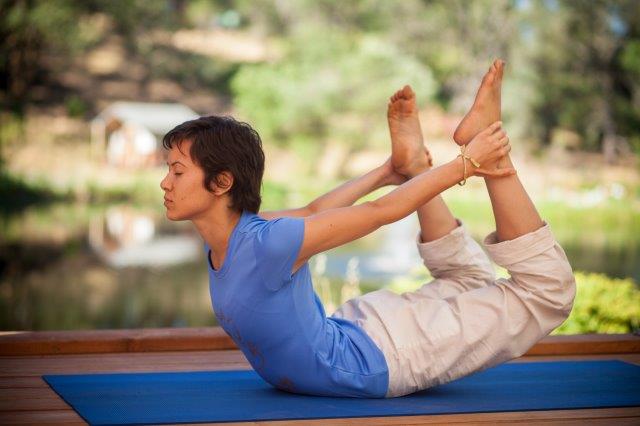
Dhanurasana – the Bow Pose

Tiptoe Balancing Pose
Proper Exercise – Asana
Proper exercise act as a lubricating mechanism for the joints, muscles, ligaments, tendons, and other parts of the body, by increasing circulation and flexibility.
The fundamental difference between Yogic exercises and ordinary physical exercises is that physical exercise emphasizes violent movements of the muscles, while Yogic exercises promote slow and conscious movements of the body, thus avoiding the build-up of lactic acid in the muscle fibers, avoiding fatigue.
Asanas
The main purpose of exercise is to increase circulation and the intake of oxygen. This can be achieved by simple movements of the spine and various joints of the body, with deep breathing, and without violent movement of the muscles.
Yogic exercises are in fact called Yoga poses (asanas), an asana being a steady pose.
Yogic exercises, when done correctly, influence and positively energize all the systems of the body: the circulatory system, the muscular and skeletal systems, the endocrine system, the respiratory system, the digestive system, and most importantly, the nervous system.
Spine Health
In terms of muscles, Yogic exercises not only strengthen the muscles but also stretch them. There is a great emphasis on the flexibility and the youth of the spine. Swami Vishnudevananda said: “flexible spine, flexible mind.”
The correct postures are performed with awareness and concentration, accompanied by breathing and relaxation. Thus Yogic exercises affect not only the physical body but also the astral body, the energetic body and the mind.
Body-Mind
Through the systematic and rhythmic holding of the postures with breathing and concentration we come to a state of relaxation in the posture, where the prana (or chi) is allowed to flow unobstructed through the nadis to all the organs, cells and parts of the body, revitalizing them.
The body and mind are harmonized with each other, removing tension located in the different parts of the body and the mind.
Also, in this process, the body and mind are put in alignment or in harmony with their ruler, the Inner spirit, thus giving to the practitioner a deeper sense of well being and meaning.
Yogic asanas prepare the body and mind to be strong for further practice of concentration and meditation.
Other exercises that can be complimentary to the practice of Yoga are swimming and walking. Yoga doesn’t promote any excessive exercise or the kind of exercise that develops only one aspect of the body to the detriment of other parts.
Furthermore, yoga doesn’t consider any exercise without awareness as a Yogic exercise. Yogic postures (asanas) are internally oriented, non competitive, and meditative, promoting calmness and helping the practitioner to transcend identification with the body; this is as opposed to our over-attachment to the body and to external beauty. To learn more check out our upcoming Beginners Yoga courses.
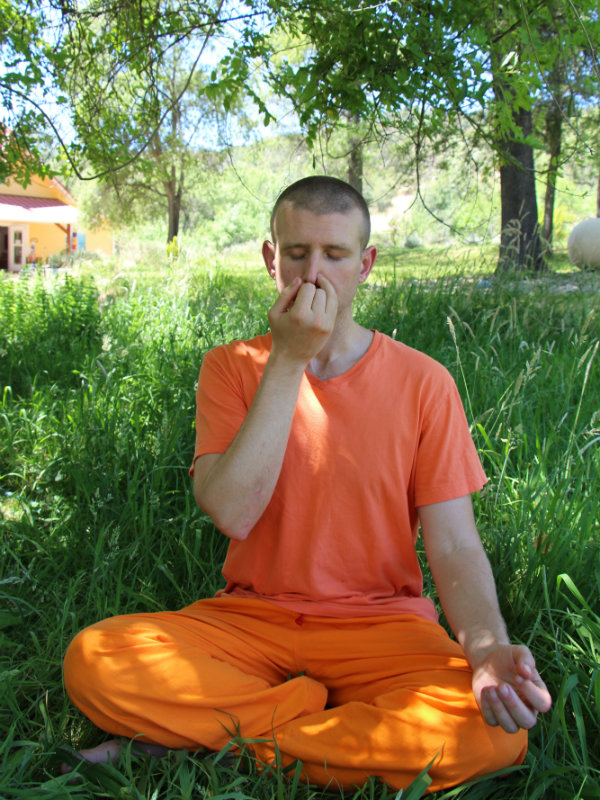
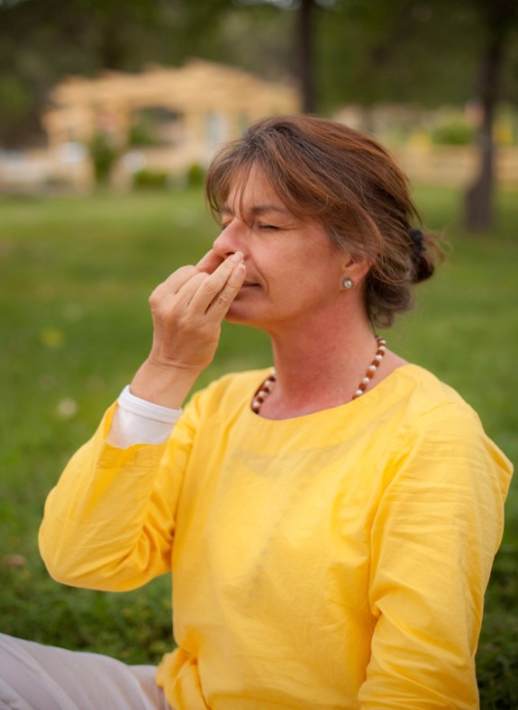
Anuloma Viloma or Alternate Nostril Breathing is the main pranayama we practice and helps balance the mind and emotions.
Proper Breathing – Pranayama
Yoga emphasizes breathing correctly (the Yogic full breath using the diaphragm). We substantially increase the intake of oxygen through deep inhalation and release the toxins appropriately through our deep exhalation.
Yoga teaches us to be constantly aware of our breathing patterns, and to breathe consciously in our daily life. Specific breathing techniques (pranayama) are devised to further purify the nadis, balance the breath and the energy in our system, and to store and channel the subtle energy (prana) for higher purposes.
The word Hatha is composed of the words Ha and Tha, which mean sun and moon, respectively. This refers to the balance between the prana vayu (the positive vital air) and apana vayu (the negative vital air).
Prana (vital air) in the body of the individual is a part of the universal breath. The regulation of the harmonized breath helps the Yogi to regulate and steady the mind. Pranayama needs to be practiced by all serious Yoga practitioners. Advanced practices need to be done only by those already practicing a pure lifestyle, and it is recommended that you put yourself under the supervision of a teacher in a pure environment, like an ashram.
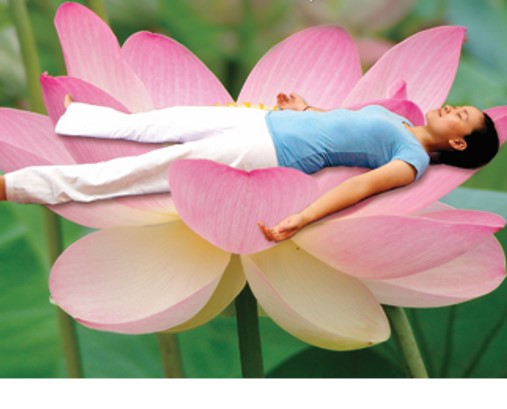

Savasana or Corpse Pose is the best way to completely relax all tension and fatigue and rejuvenate the body and mind.
Proper Relaxation – Savasana
Relaxation techniques, such as Savasana, cool down the system like the radiator of a car. When the body and mind are constantly overworked, their efficiency diminishes. Relaxation is nature’s way of recharging the body.
The state of our mind and the state of our body are intimately linked. If your muscles are relaxed, then your mind must be relaxed. If the mind is anxious, then the body suffers too.
3 Levels of Relaxation
We can say that there are three levels of relaxation: physical, mental and spiritual; there are also three levels of tension, or stress: physical stress, mental stress and spiritual stress. Relaxation is actually very scientific. Please read our article on The Science of Relaxation to learn more.
Physical stress comes from poor eating habits, sedentary living, repetitive movements of the body, and poor posture. Modern life, especially in big cities, is full of stress as modern working and living conditions are full of pressure, and devoid of prana and relaxation.
Mental and emotional stress comes from a hectic lifestyle, highly demanding jobs, distractions of the mind, low vitality due to lack of prana, and negative emotions such as anger, hatred, jealousy, fear, and anxiety.
Spiritual stress comes from existential anxieties, from living with questions without answers, such as “what is life and death?”, “what is love?”, “what is the nature of our connections with God?”, “is there a God?”, “why are there inconsistencies and unrighteousness?”, “how can one find stability in the ever changing phenomena of life?”, “why are we suffering from disillusions?”, and “why can’t we achieve enduring peace?”
The solution is to achieve the three levels of relaxation:
Physicial Relaxation
Physical relaxation is achieved through the systematic practice of conscious relaxation (Savasana) and correct posture.
Mental Relaxation
Mental relaxation is achieved through correct breathing, concentration of the mind and positive thinking. A distracted mind is always anxious. A mind concentrated on a positive object is more relaxed and recharged.
Spiritual Relaxation
Spiritual relaxation is a deeper type of relaxation, when we become content, a detached witness of the body and mind. Swami Vishnu-devananda states that being free from identification with the body, the mind, and ego consciousness is the only way to reach a state of complete relaxation. (ref. CIBY p. 203)
Through complete relaxation we live in the solid present, overcome our fears of death and of the future, and welcome life’s demands with strength and courage, able to guide our mind, control our desires and choose better priorities.
Check out our upcoming Stress Relief and Relaxation Courses >>


At the ashram we eat healthy, nutritious vegetarian meals in a community setting.
Proper diet – Vegetarian
Correct nutrition and diet gives proper fuel for the body and the mind without creating toxins and digestive problems. Optimum utilization of food, air, water and sunlight is essential.
There is medical evidence that a balanced vegetarian diet is extremely healthy and provides everything the body needs. The Yogic vegetarian diet is sattvic (pure), and helps to calm the mind, and to reveal the spirit as well as nourish the body.
The body needs food for two purposes: as fuel to supply energy, and as materials to repair body tissues. For repairing and building tissue, the body needs: 1. protein; 2. carbohydrates; 3. fats; 4. minerals.
These elements are found in larger proportions in vegetable tissue than in animal tissue. Nuts, peas, beans, soy bean products like tofu, and milk contain protein. Wheat, oats, rice and other grains are mainly carbohydrates.
All protein foods and vegetable oils provide the fats, and the main supply of organic minerals and vitamins comes from fruit and vegetables.
A vegetarian diet is a natural diet, fresh and wholesome, full of fiber and alkaline in nature, energy producing, and easy to absorb and to eliminate.
Sattvic Diet
To maintain a sattvic diet, free from rajasic and tamasic influences, avoid stimulants and depressants such as caffeine, alcohol, cigarettes, drugs of all kinds, overly spicy food, onions, garlic, overcooked food, old food, frozen food, canned food, sodas and processed foods, as well as all meat.
Yogis advocate “ahimsa”, the principle of non-violence, non-injury and respect for life. Everything our body and mind needs for growth can be provided from the vegetable kingdom.
By avoiding eating animal flesh we nourish ourselves in a natural and healthy way.
The vegetarian diet helps in the performance of asanas as the body and the joints becomes more flexible. It is a wonderful way to prevent heart disease, arthritis, obesity, and a good remedy for many chronic diseases.
Gradual Change to Vegetarian diet
Changing to a vegetarian diet can be gradual and life transforming. It consists not only in deciding to stop eating meat, but in learning a new way of life, by being conscious of how you nourish yourself.
It includes not only being aware of what you eat, but also how you eat. Yogis promote taking time to cook, and to eat consciously in a regular manner, with appropriate intervals between meals to allow the digestive fire to activate and digest the food.
Blessing meals is also encouraged to sanctify the act of eating and for offering thanks to the Creator.
Proper diet includes periodic fasting as well, to give a break to the digestive system, purify body and mind, and to make the mind more perceptive, more sattvic, and more conducive to concentration, contemplation and meditation.
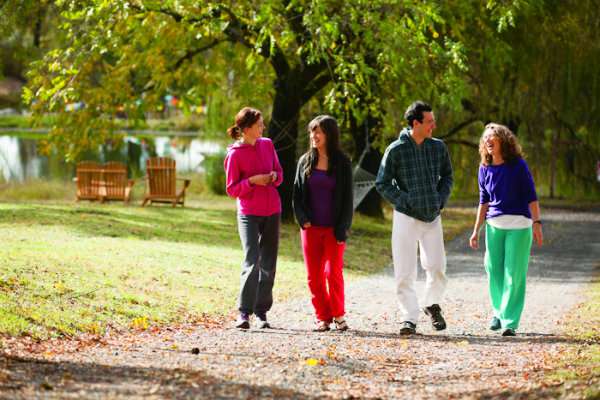
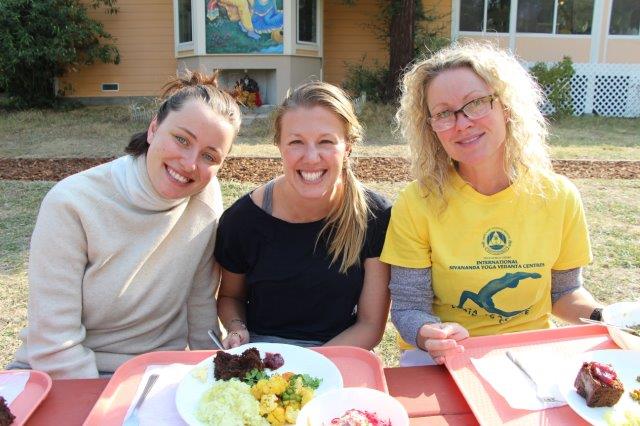
In order to practice meditation one has to always be aware of the mind and keep the thoughts positive and uplifted.
Positive thinking and meditation
Just as a driver of a car manages to bring himself to his destination without accidents and setbacks, so the yogi learns to manage his mind and emotions in order to keep him positive at all times. You can read about this in detail on our Positive Thinking our teachings page.
Positive thoughts are energizing and facilitate growth, while negative thoughts are draining and inhibit growth.
Only with a positive outlook about oneself can one can maintain a meditative life which will ultimately lead to intuitive knowledge and inner strength. We have an Ultimate Guide to Positive Thinking which is based on a webinar taught by Swami Sitaramananda.
Check our upcoming Positive Thinking Courses >>
Check our upcoming Meditation Courses >>
Yoga Teacher Training Course
Check out our 200-hour Yoga Alliance certified Yoga Teacher Training Courses offered twice a year in California, 3x in Vietnam, once in China and once in Japan.
Foundational Courses
Choose from upcoming courses for beginners and intermediate level students.
Yoga Vacation
Rejuvinate your body and mind. Experience and progress with daily Yoga classes. Learn the 12 basic asanas and pranayama. Enjoy daily meditation, chanting, and organic vegetarian meals.
Check out our Blog
Our Sivananda Yoga Farm Blog has numerous articles, videos, and talks given by our senior teachers over the years.
OUR TEACHINGS
The contents you will find here are reproduced from the book “Essentials of Yoga Practice and Philosophy” compiled by Swami Sitaramananda.
Satsang
What is Satsang? What is Meditation? What is Kirtan Chanting?
5 Points of Yoga
Exercise, Breathing, Relaxation, Diet, Positive thinking and Meditation
Health
What is True Health? What is health of body, mind, and spirit?
Prana
What is Prana? How can I access prana? What is kundalini energy?
Raja Yoga
What is Raja Yoga? What are the eight limbs? What is ashtanga yoga?
Jnana Yoga
Who am I? What is Vedanta Philosophy? What is Sat-Chit-Ananda?
Mantras
What is a mantra? What is sanskrit? How do I get a mantra?
Yoga Poses
What is in a basic Sivananda class? What are the benefits? What are some guidelines?
Yoga
What is Yoga? Where did Yoga come from? What is Classical Yoga?
Life
What is the meaning of Life? What is Freedom? What is Happiness?
Mind
What is the mind? How does the mind work? Am I my mind?
Positive Thinking
What is thought? What are techniques to practice positive thinking?
Karma Yoga
What is Karma? What is Karma Yoga? How to practice karma yoga?
Bhakti Yoga
What is True Love? Who is God? What is an inner Bhava?
Kirtan Chanting
What is Kirtan Chanting? How does it work? What do the chants mean?
Ayurveda
What is ayurveda? What are the 3 doshas? What is disease according to ayurveda?